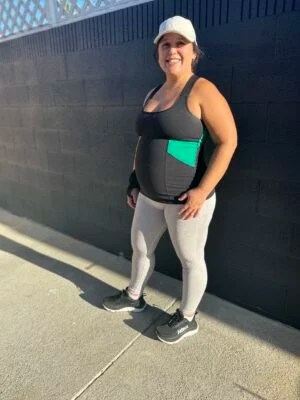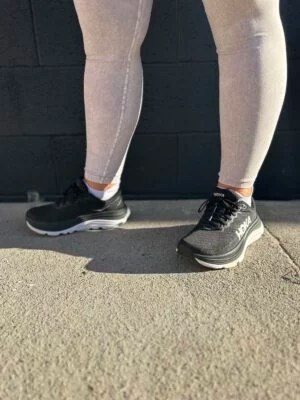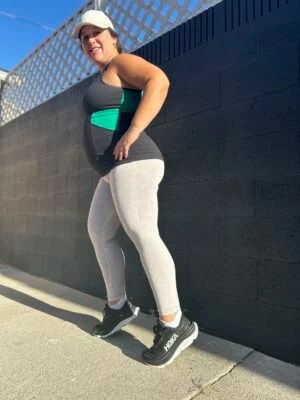Hoka shoes are known for their fat, comfy soles. So what does a Hoka shoe that’s the maximum stability and support version of the entire Hoka line look like? Behold the Hoka Gaviota 5.
I’ve been running and walking in a pair of the Gaviota 5s ($175) for a couple months now, and my feet have never felt more protectively and comfortably encased from whatever the sidewalk throws at me. The landing is soft, the rocker sole feels natural, and my (very low) arches are bolstered. The base is dramatically wider than the foot bed, which makes me feel balanced and safe.
However, the Gaviota 5s are not necessarily for everyone. As someone with a wide, flat foot who tends to pronate, and with a curvier body to support, I’m really looking for a maximum support and stability shoe with a wide toe box—which is what the Gaviota 5 offers. But if you have a neutral arch, narrow foot, and prefer to have a lighter or more minimalist feel in your footwear, the Gaviota 5 is probably a lot more shoe than you need.
Experts In This Article
- Robert K. Lee, DPM, chief of podiatric surgery at the UCLA Santa Monica Medical Center and past president of the Los Angeles County Podiatric Medical Association
“The kind of shoe that a person should wear really is going to be dictated by their foot structure and biomechanically how it tends to function during the gait cycle,” says Robert K. Lee, DPM, chief of podiatric surgery at the UCLA Santa Monica Medical Center. That said, Dr. Lee does often recommend a highly cushioned athletic shoe, especially if the patient has any sort of foot pain. “Hoka has become the most recommended shoe by podiatrists or any foot and ankle specialist because from a health standpoint, from the standpoint of preventing injury and also from the standpoint of maximum comfort, there’s no shoe that has made more of a difference.”
Hoka Gaviota 5 — $175.00
Combining the softness of a support shoe with the firmness of a stability shoe is a tall order. But the Gaviota 5 manages to combine a cushy sole with a noticeably arch-supporting midsole, plus a wide toe base to boot.
- It’s got that signature Hoka ultra-cushioned sole
- An updated stability frame limits side-to-side motion to prevent arch collapse
- Comes in five gorgeous colorways such as “Airy Blue” with a “Sunset Ocean” sole
- Noticeably wider than other “wide” shoes
- Cushioned collar prevents heel slippage
- Heavier than other Hokas
- Stability component makes them not as soft as Hoka’s other max-cushion shoes
The ultimate stability and support? Here’s what that actually means
The Gaviota 5 is supposed to provide the same support as Hoka’s max cushion Bondi, but with stability features to boot. Understanding what support and stability actually mean are important when determining whether the Gaviota 5 might be the shoe for you.
“Support and stability are often kind of used interchangeably, but they’re not always the same thing,” Dr. Lee says.
Support refers to a shoe that cushions the foot from impact, explains Dr. Lee. Shoes achieve this a few ways—most obviously with a thick, soft sole that absorbs pressure from the ground. That thick sole is also rigid, and in a rocker design, so that your toes and forefoot don’t have to bend as much to propel you off the ground.
“It’s protecting joints, so there’s less pressure on various pressure points in the foot, and it limits stress when they’re walking,” Dr. Lee says.

On the other hand, a stability shoe minimizes side-to-side motion when you step, which is something you want if you have either flat or too-flexible arches. A rolling inward of the arch is called pronation, which can cause foot pain and other problems like tendonitis, plantar fasciitis, and more.
“The more your foot collapses, the more flexible it is, the harder your muscles have to work trying to stabilize that foot,” Dr. Lee says. “So if you’re running, your flexible foot has to work harder to stabilize it for you to plant and push off the various tendons and ligaments compared to someone who’s got a naturally more stable foot that doesn’t collapse as easily. So that person is in theory, going to fatigue a little bit quicker, or they may be more prone to an overuse syndrome.”
One possible solution is wearing a stability shoe. “It’s a denser material, and so that’s providing more support on the medial side (or on the instep area) to prevent that collapsing motion,” Dr. Lee says. “So stability inherently means really blocking pronation. That’s the function and the purpose.”

Because of that rigidity, stability shoes can sometimes be clunkier or less soft than pure support shoes. As a hybrid stability and support shoe, the Gaviota 5 is supposed to combine the soft foam sole of “Bondi-level cushioning” with a stability “H frame” (a base that runs around the perimeter and across the middle of the shoe) to make it luxurious and stable at the same time.
What it’s like to walk and run in the Hoka Gaviota 5
The Bondi 8 has been my walking shoe of choice for the last year, so I was excited to try the Gaviota 5 since its sole looks so similar to the Bondi. A Hoka store rep also suggested the Gaviota to me when I told him that the Bondi gave me blisters in my arch on runs; he said this was a common complaint among flatter-footed customers, and that the Gaviota might be a better fit.
And it turns out, he was right. I haven’t gotten blisters on runs in my Gaviotas. However, the extra firmness of the stability element has also taken some getting used to. The Gaviotas don’t feel like quite the cloudy dream that the Bondis do. The Gaviotas are still springy and cushy. But there is a firmness, particularly on the sides in the midfoot (like there’s supposed to be), that is noticeable.
But it’s possible that this will help me in the long run. My feet felt a bit cramped in the shoe when I wore them with my insoles. That made me wonder whether I really needed that extra arch support in this shoe? I’ve long wondered whether orthotics made my plush running shoes less comfy because of the rigid board between me and all that soft soft foam. But I haven’t ever had a choice, really. Typically, if I wear any shoe without insoles for walking and certainly for running, my feet start to hurt pretty quickly. But I’ve been able to go on long walks in the Gaviotas without the insoles and my arch never feels like it’s collapsing like it usually would. Dr. Lee says it varies from between his patients, but some have found that a stability shoe makes insoles unnecessary.

I can also tell that the Gaviotas are wider than my other shoes. My running insoles that fit perfectly in my other size wide shoes don’t take up the full footbed in the size wide Gaviotas. I don’t know that the width extends beyond the forefoot—again, I do feel a bit of a squeeze around the arch—but the toe box is certainly roomy.
They also have an extra-wide base, which Dr. Lee says shoemakers add to counteract the potentially wobbly feeling of the rocker design. So between the width and the base, the Gaviota 5s make quite the footprint.
That doesn’t bother me at all. In fact, it makes me feel super stable, hugged, and supported. That’s only emphasized by the exaggerated cushy collar that keeps my feet in place and heel from slipping out, something I sometimes have an issue with in other shoes. But the Gaviotas do have a heft that I never seemed to notice with the Bondis. Dr. Lee says that’s typical with a combination stability and support shoe.
“Stability shoes tend to be heavier because they’re a little denser material to block that motion,” Dr. Lee says. “If you’re a competitive runner, you want to be as light as possible, so you’re not going to want those features unless you really need it.”
Figuring out whether you need the stability in addition to the ultra-cushioned support is the biggest question when considering the Gaviotas. I have other support and stability shoes that feel neither as rigid nor as heavy as the Gaviotas. However they don’t have that gold-standard Hoka fat sole. I’m not sure the Gaviotas achieve double-duty perfection thanks to their heft and midfoot firmness, but they’re certainly a contender for those among us forever searching for our stable yet supportive glass slipper.
Our editors independently select these products. Making a purchase through our links may earn Well+Good a commission.
